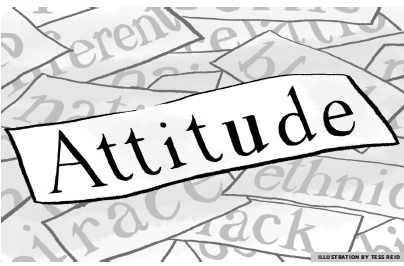Picture yourself at a grocery store. You’re unloading your cart onto the conveyor belt as the cashier noisily chews her bubble gum and stares at you impatiently.
You say hello and smile; she doesn’t smile back. She barely says two words to you and rushes you through the check-out line.
As you walk away, you probably think to yourself, “That cashier has a bad attitude.”
Now imagine the ethnicity of this particular cashier. Would your perception of the situation change if this person was white, Asian, or black?
Many social experiments suggest our perceptions of the attitudes of other people are affected by race.
A 2003 article from the journal Social Psychology Quarterly refers to several social race survey experiments in relation to attitudes.
One particular experiment showed most black respondents seemed to downplay their personal achievements and complaints when their interviewer was white, becoming more complacent and docile.
When being interviewed by a black person, black people were much more open and revealed deeper feelings regarding inequality. Interestingly, survey ratings of politeness and warmth were higher for white interviewers.
This experiment suggests people of the same race display similar attitudes when communicating because they share cultural commonalities.
When interviewed by someone of a different race, that common ground is lost, causing the respondents to behave less naturally.
Attitude is acted and received differently depending on the relationships between people, and as race plays a role in determining these relationships, it makes sense that race relations must be considered as a factor when we perceive the attitudes of other people.
It is important to clearly define what is meant by attitude.
According to Shila Khayambashi, a graduate student and member of PREVNet, an anti-bullying organization with a chapter at York, attitude is a highly complex human mechanism.
Based on our past experiences, we build expectations for future situations and then develop predetermined behaviours.
Let’s examine again the cashier. It is possible she may have had a frustrating experience in the past with a customer of a particular race, who was disgruntled for their own reasons.
From this experience the cashier may have developed a prejudiced predisposition to customers of that particular race.
That is not to justify prejudice, but to demonstrate how attitudes are a complex mechanism of social interactions and can sometimes become problematic and sensitive.
It is important to realize that attitude is a two-way process, involving projections of attitude towards others and how that projection is received.
Attitude cannot be simply explained and should not be seen as a reduction of a complex individual.
There is a lot that must be considered in our perception of a particular attitude.
It’s also worth noting that this cashier might be stressed because of a test she hasn’t studied for. She may be under pressure from her family to move out, her manager at work might be mistreating her, on top of her past troubling experiences with difficult customers that all play a role in forming her attitude.
Attitude is circumstantial, and if you came back to the store tomorrow, her attitude may not be the same.
Ashley Glovasky
Deputy Copy Editor



